
Collector's Club Photos
Welcome to the Collector's Photos page.
Here is where you'll see some of the rarest pieces of Victorian Opalescent Glass.
The pieces shown here are currently in private collections. I am honored to be able to show them.
If you have a piece in a rare shape or color and would like to have it listed here, just send it along
in an email.
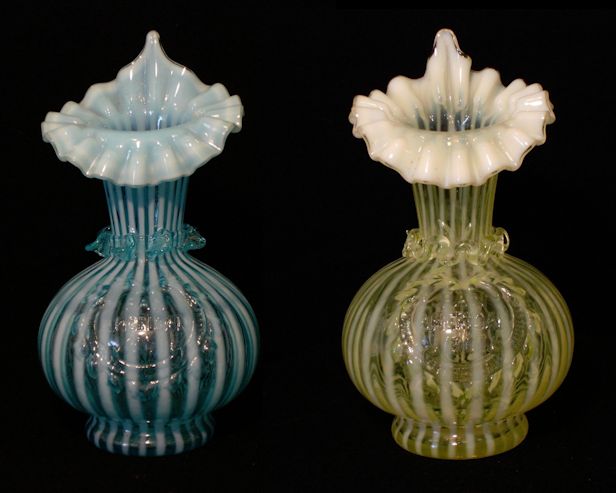
Here are two of the rarest items made by Northwood. These are the "Pan American 1901" vases. They are
embossed with an emblem that says "Pan American 1901". The Blue vase is the exact same vase
that was photographed and used on the cover of "Northwood the Early Years". Notice the applied rigaree
around the neck. Although Cranberry and Flint (White) Opalescent are not known to exist, it's possible they were
made in those colors as well.
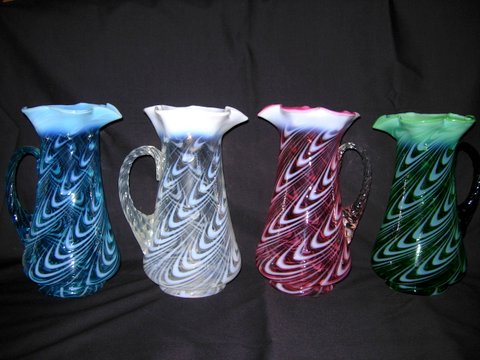
Most of us would be happy to find just one of these. But here is a group of all four Tankards in "Blown Twist"
in all the colors known in this pattern. Green being the rarest color to find this Tankard in.
This photo is courtesy of an Oregon collector.
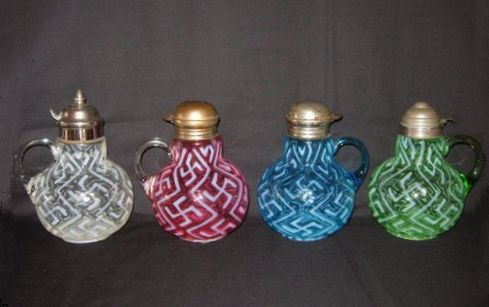
Once again we'd all just love to have one of these. But here is a group of all four Syrups in "Swastika"
in all the colors known in this pattern. Green being the rarest color to find.
This photo is courtesy of an Oregon collector.
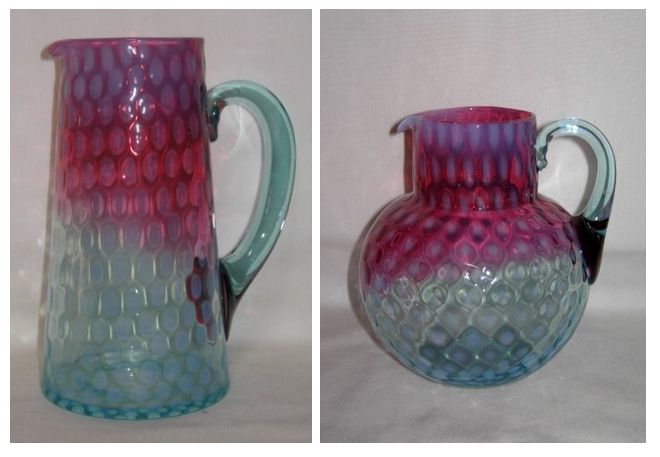
What can I say but "WOW"! These two pitchers are a product of the Phoenix
Glass Company. They are an extremely rare color called "Ruby Die-away". The color is shown
in the Phoenix Art Glass book by Lee Marple, and it's called a Heat Sensitive Ruby Die-away.
Hobbs Brockunier patented a Heat Sensitive Blue glass and called it "Bluerina". This Ruby Die-away
is similar. This Blue color Heat Sensitive glass has to be struck at the furace in order to get the Ruby Color.
The opalescent pattern is same one used in "Opalescent Diamonds".
The photos are courtesy of an Oregon Collector. It's great to show these.
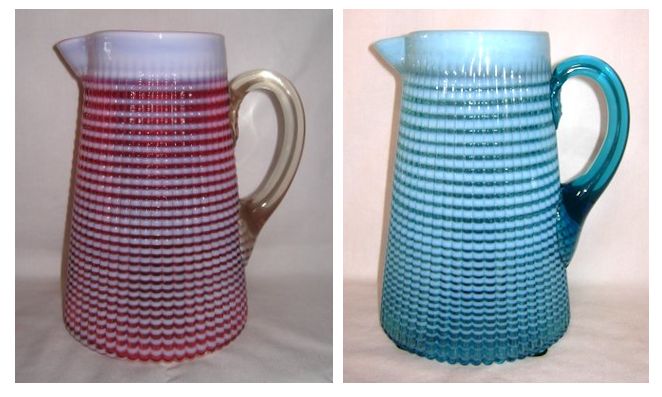 .....
.....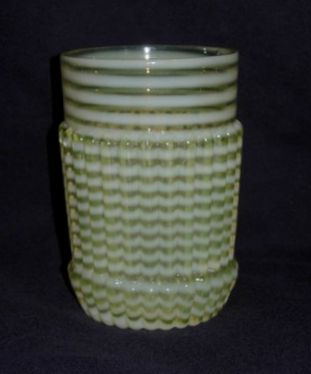
What can I say but "WOW" again! These two pitchers are a product of the Northwood
Glass Company. They are extremely Rare. It was all but impossible to find a picture
of this pattern in the Tankard shape. But here we have two! The pattern is called "Opalescent Rings"
and it's also known as "Ribbed Opal Rings". You certainly won't find these too often.
The recent discovery of a Tumbler shown in Vaseline Opalescent means this Tankard can be found
in Vaseline Opalescent as well. The Tumbler is currently the only one known to exist.
The photos are courtesy of an Oregon Collector. It's great to show these extremely rare pieces.
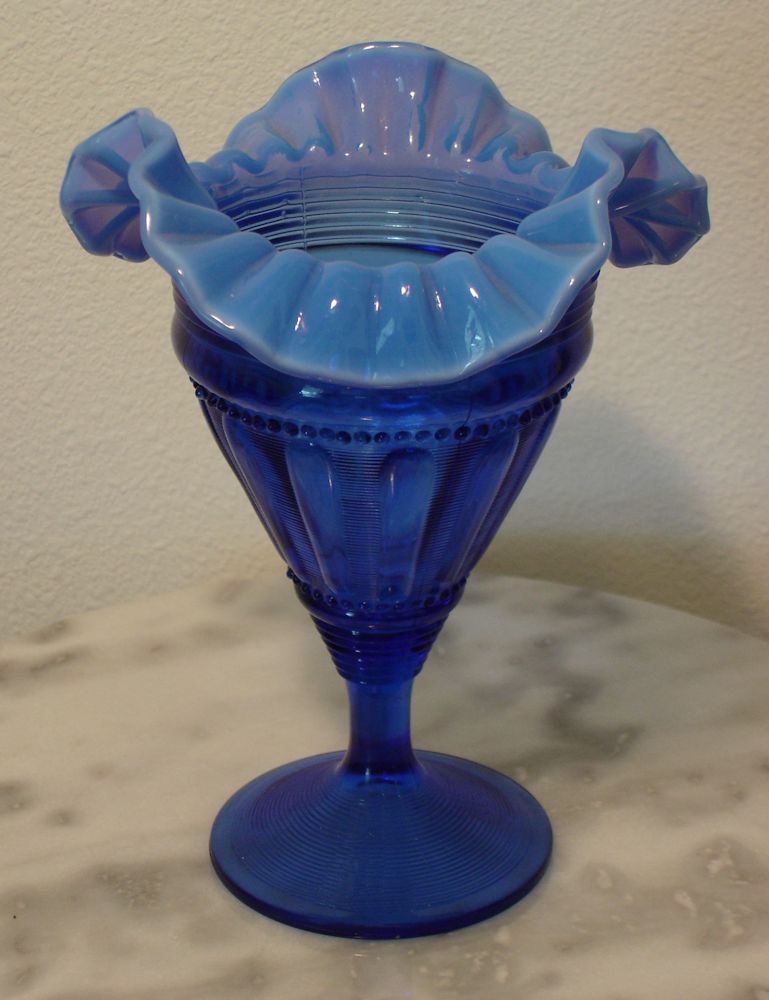
Here's an extremely rare item just recently discovered. This is a known pattern
by the Jefferson Glass Company called "Fluted Bars & Beads". The
color is what's rare. This is "Cobalt Blue" Opalescent. Two date this is the only
known example in this pattern in this color. What an amazing find! Proof that there
are still extremely rare items out there to be found.
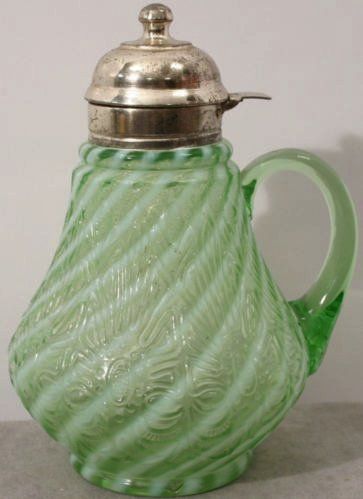
Here's an extremely rare pattern in Opalescent Swirl called
"Aztec Medallion Swirl". In fact in Opalescent colors this Syrup is
the only known item made. Green is the only color known. The maker is still unknown.
It was great to be able to get this photograph to show how unique the pattern is.
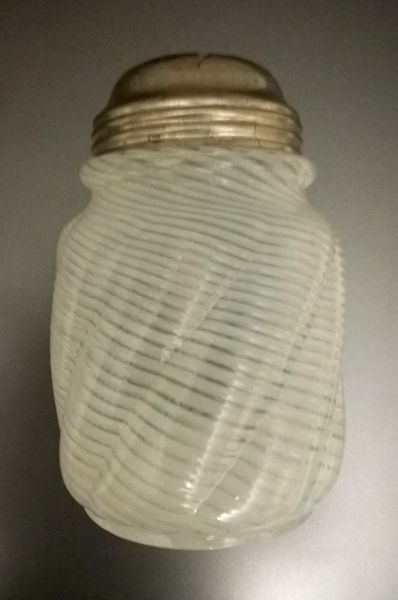
Shown here is a very rare "Parian Swirl" Sugar Shaker with a very fine Swirl Opalescent pattern.
This photo is courtesy of collector Scott Beale. Thank you for sending it in.
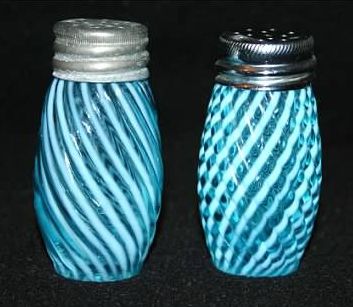
Shown here is a comparison photo of a "Reverse Swirl" Salt Shaker. The Shaker shown on the right
is how it's normally found. On the left is a Shaker from the same mold only the stripes are traveling
in the same direction as the molded ribs. Very unusual indeed. This photo is courtesy of collector Scott Beale.
Thank you very much for sharing.
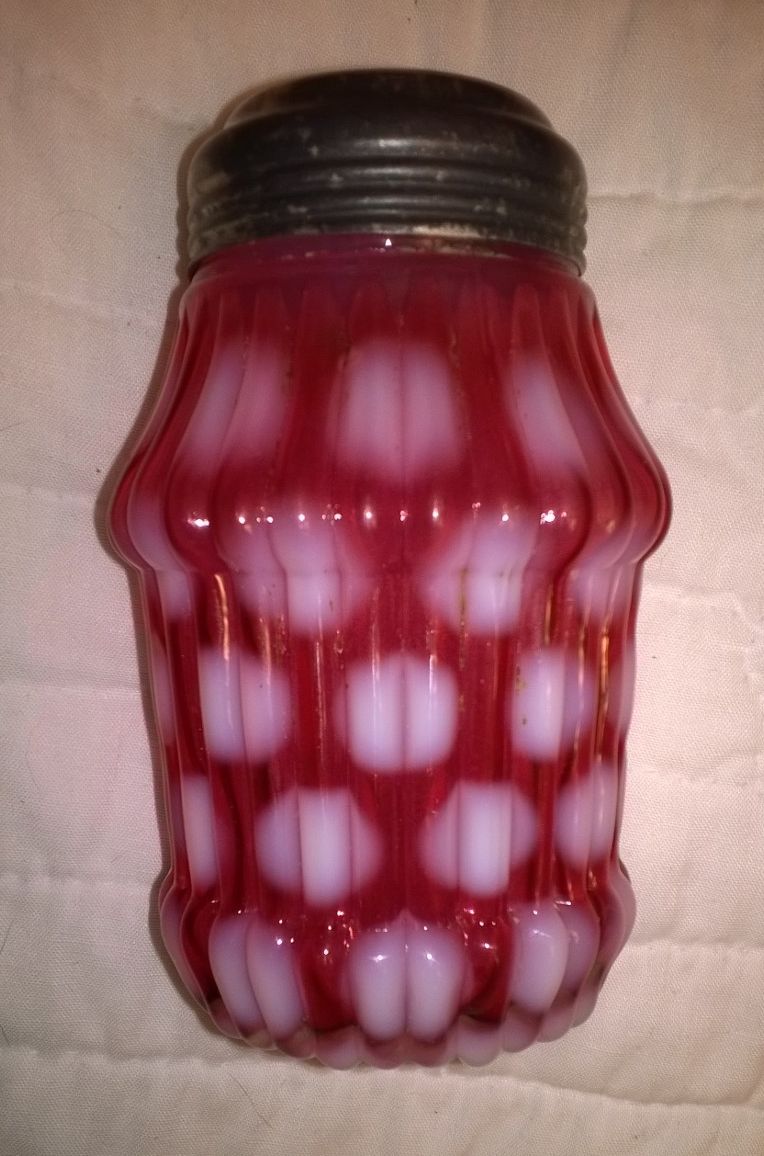
Shown here is the very rare "Ribbed Coinspot" Sugar Shaker in Cranberry Opalescent.
This photo is courtesy of Scott Beale. Thank you very much for sending it in. It's great to show it.

Shown here are the original authentic Salt and Pepper Shakers in the Alaska pattern. They are extremely rare.
It's been discussed at great length by Bob and Carol Bruce about why these shakers are so rare and it seems
it's because of a production problem Northwood had with the moulds. So Northwood discontinued making them and used
the Klondyke (Fluted Scrolls) Salt and Peppers for both patterns which are the ones most often found today. I am very
pleased to be able to show these extremely rare shakers. The photo is courtesy of collector Rick Graham.

Here are a couple very rare Barber Bottles. You won't see these very often. On the left is "Blown Drapery"
in Cranberry Opalescent made by Northwood. On the right is "Daisy in Criss-Cross" in Blue Opalescent
made by Beaumont. It's the only one I've ever heard of or seen. It's great to be able to show these very
rare and wonderful examples. Photos are courtesy of collector Rick Graham.
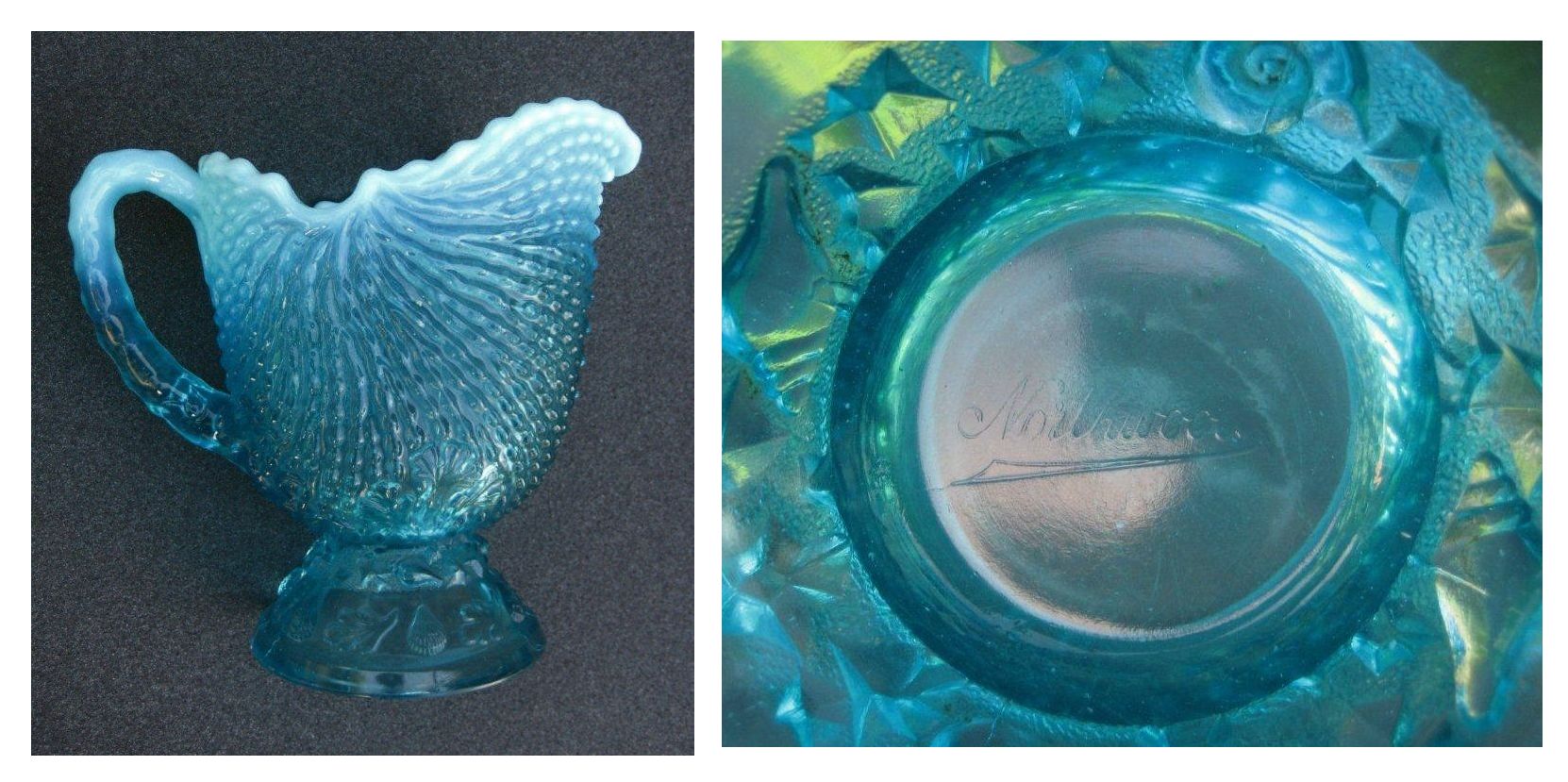
Here is another rare and great find. The photo is provided by collector Rick Graham.
This is the Blue Opalescent "Water Pitcher" in the pattern "Nautilus", also known as "Argonaut Shell".
It has the early Northwood script signature. This piece is usually found in Custard Glass. It was first
made in 1900. Harry Northwood turned control of the National firm over to Dugan in 1904. The Nautilus
moulds were transferred to Dugan at which time all Northwood signatures were removed from the moulds.
So we can date this pitcher pretty accurately sometime between 1900 - 1903. It's great to be able to show it.
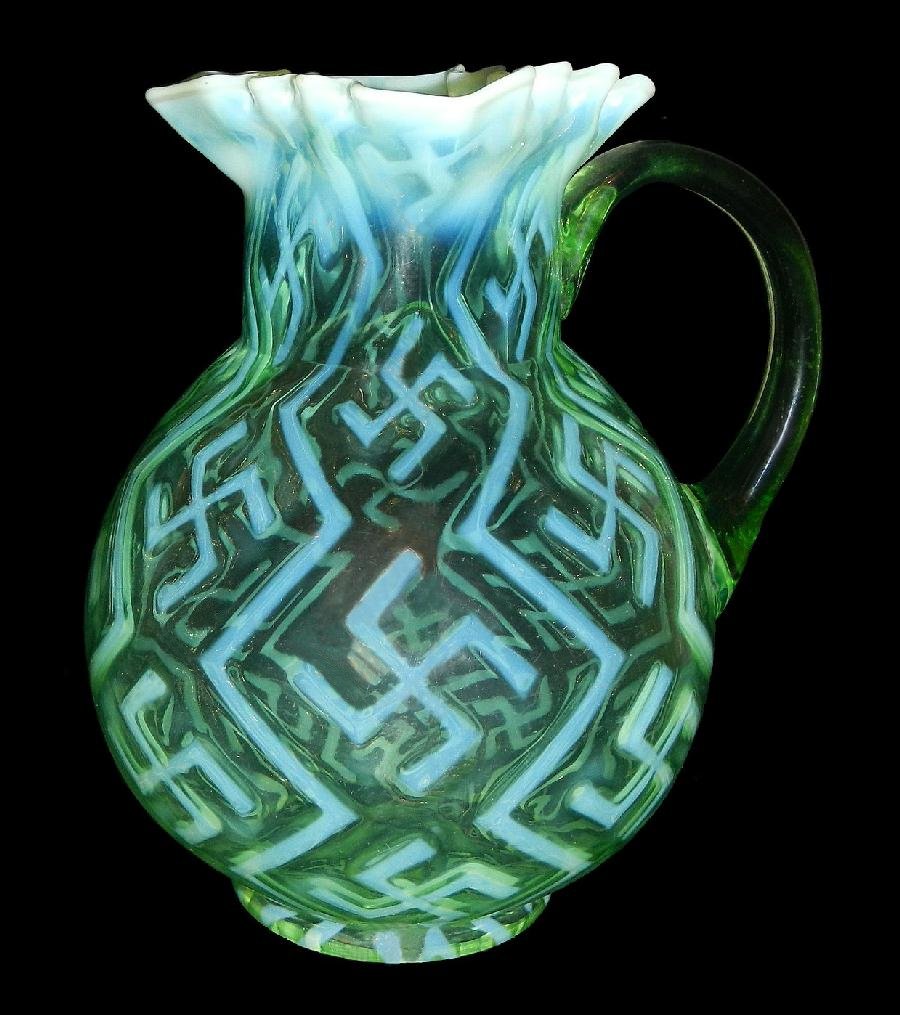
What a great find this was. The photo is provided by collectors Frank and Melissa Keathley.
This find changes everything we know about when and possibly who the original maker was.
View the info here.
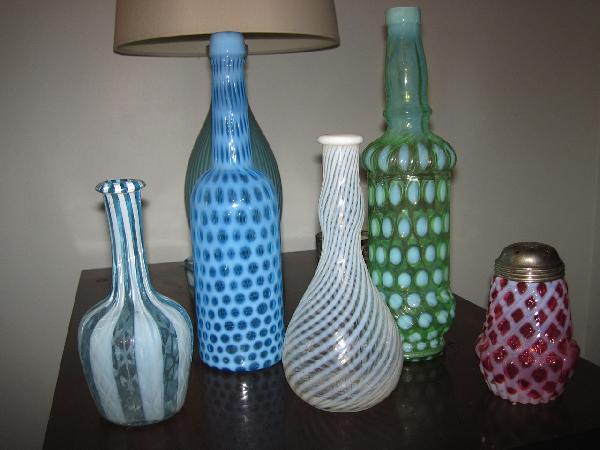
Until I saw this picture I was not aware of the Coinspot Bar Bottle in Green Opalescent
What a rare find this is. I've only seen Cranberry and Blue. I would imagine a White
one probably exists as well but I have not seen that either. Photo is courtesy of Bill
Bowen. Also notice the Blue Opalescent Windows Bar Bottle which is also quite rare.
And finally, what a rare treat to show the Blue Opalescent Barber Bottle in "Wide Stripe
with Diamonds". It's really great to be able to show these rare items.
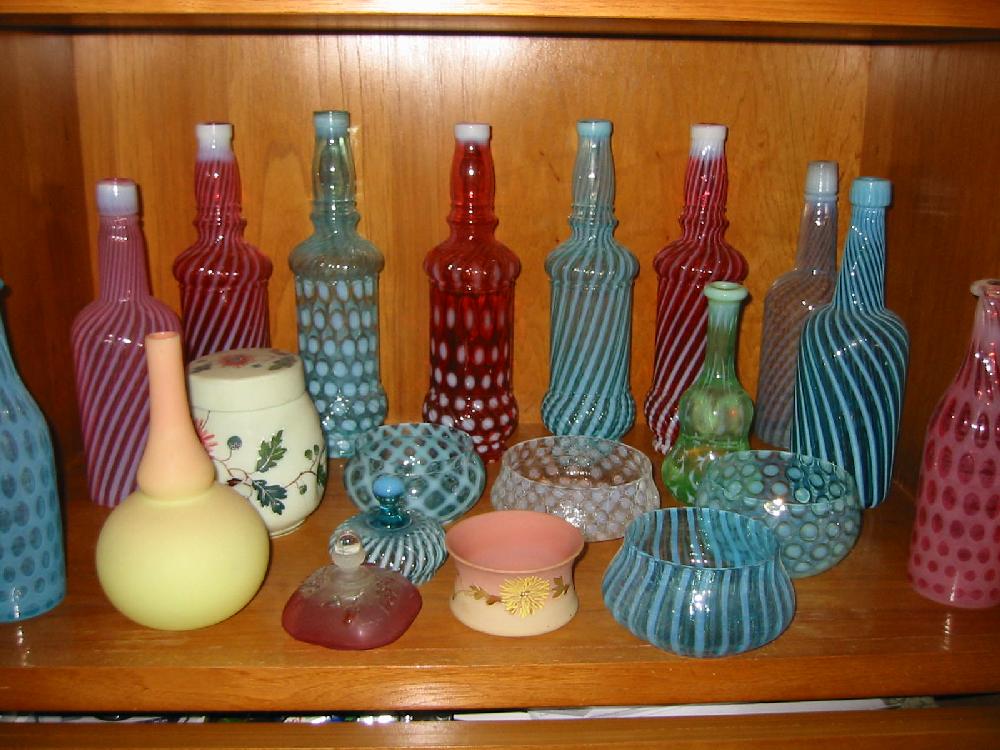
Here's a grouping of Opalescent Bar Bottles submitted by collector Bill Bowen.
Also shown is a group of what appear to be "Finger Bowls". There is also a nice rare
Green Opalescent Barber Bottle in Spanish Lace. Thanks for sending it in. It's nice to be able to show these.
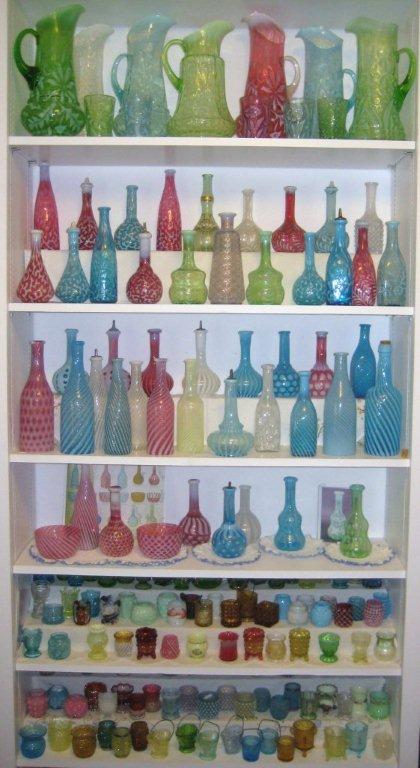
Here's an impressive collection of many Opalescent glass items.
A special thank you to Rick Graham for sharing.
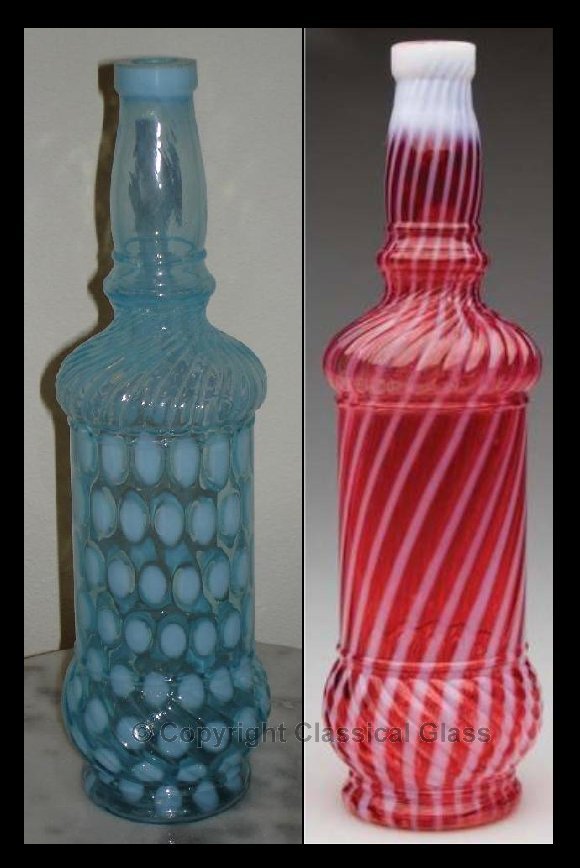
These are the only two known patterns for the Bar Bottles in the Chrysanthemum Swirl shape made by Northwood.
Both Coinspot and Swirl spot moulds were used, and then blown from the same shape mould. For years
they have been included in the Chrysanthemum Swirl pattern based on their shape. However they are
actually a variant of Chrysanthemum Swirl. These are shown in Heacocks's book 9 in black and white.
I'm very pleased to be able to show both of these rare Bar Bottles in color.
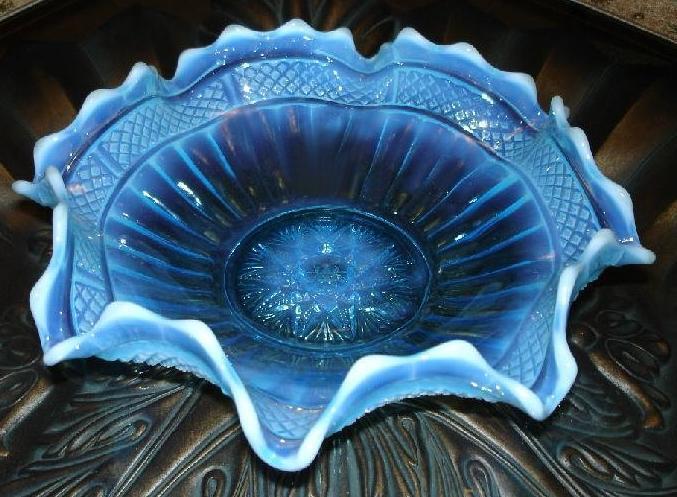
Here's a rather rare Whimsey bowl in the "Lustre Flute" pattern by Northwood.
It was made from the Master Berry Bowl and is signed with the N in a
circle. Currently, there are only two known in Blue Opalescent. This one shown and
one is on display at the West Virginia Museum of American Glass.
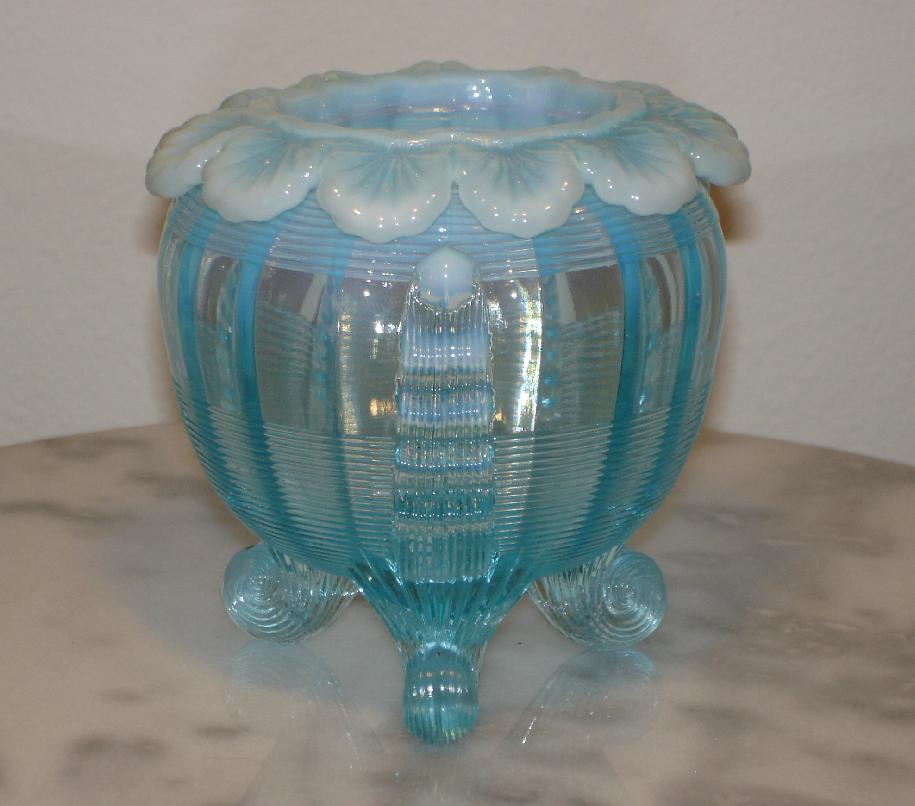
This is a Northwood pattern called Klondyke (Fluted Scrolls).
The item is a True Whimsy made from the Rose Bowl. This is the only one
I've ever seen or heard of with the scallops flattened down at the top.
It may have been made for use as a Lady's Spittoon. It is known that
some woman in Harry Northwood's family chewed Tobacco.
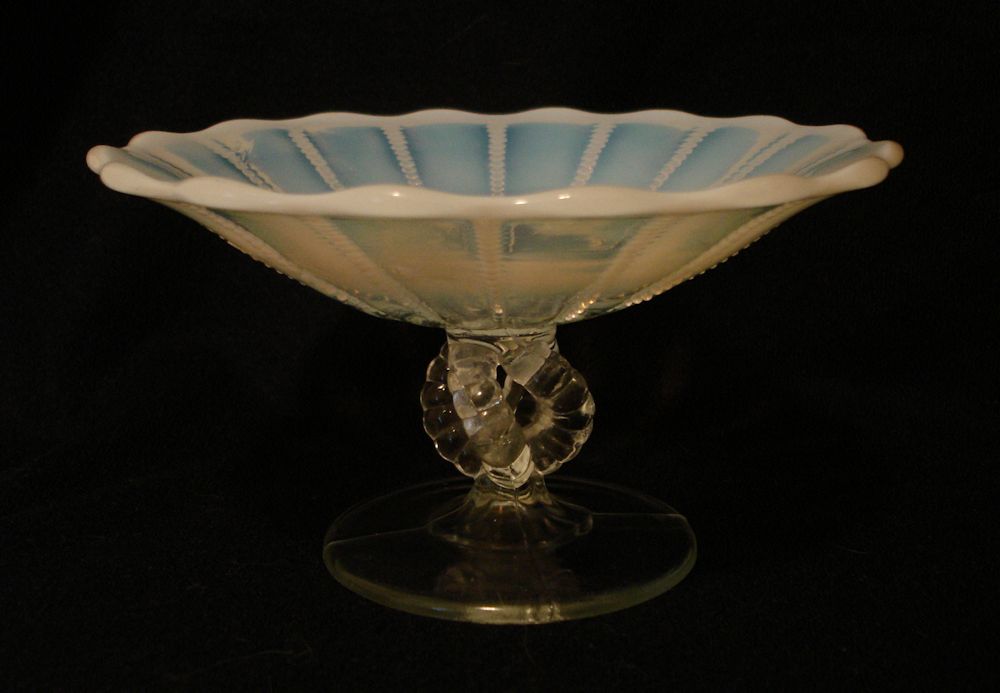
This is a Northwood and Dugan pattern called "Opal Open".
The item is a true Whimsy. This is the only one of these I've ever seen
with the stem twisted.

This is a wonderful Block pattern JIP shaped bowl by Jefferson. The
color is an extremely rare Cobalt Blue Opalescent color. There are
only two of these known to exist.

Rare grouping of Beaded Drapes JIP shaped bowls
with all three color Fritts by Jefferson Glass Co.
Cranberry, rare Green, extremely rare Colbalt Blue
It took 20 years to find all three colored Fritts
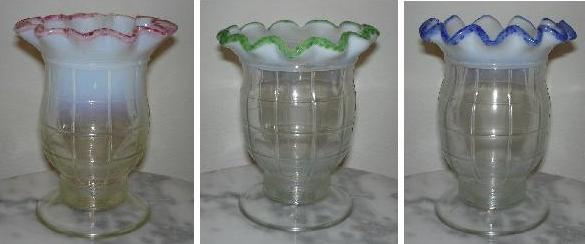
Rare grouping of Block Celery Vases with all
three color Fritts by Jefferson Glass Co.
Cranberry, rare Green, extremely rare Colbalt Blue
It took 20 years to find all three colored Fritts
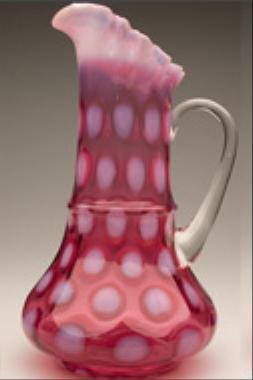
This is the extremely rare coinspot pattern by Dugan in the Ribbon Tie mould.
The only known Opalescent pattern used for the Ribbon Tie mould
was Spanish Lace. What a treat to show this extremely rare piece
in Coinspot, and in Cranberry no less.
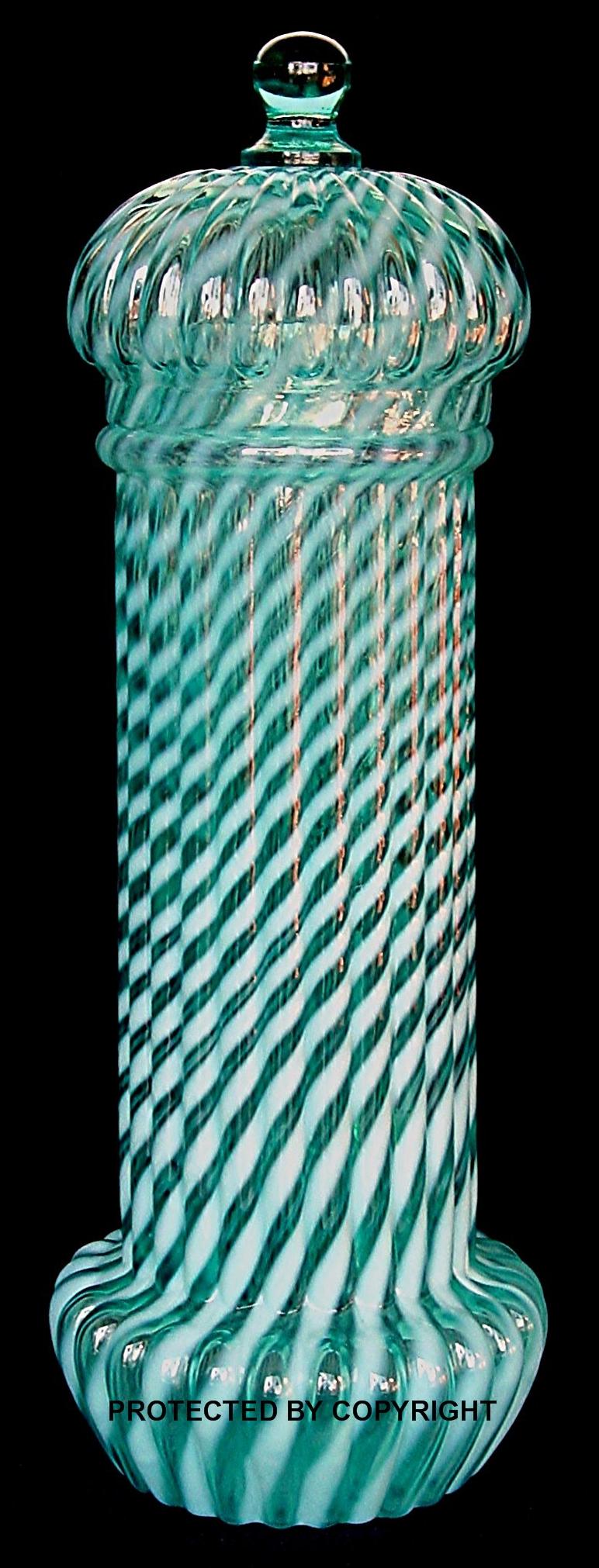 ........
........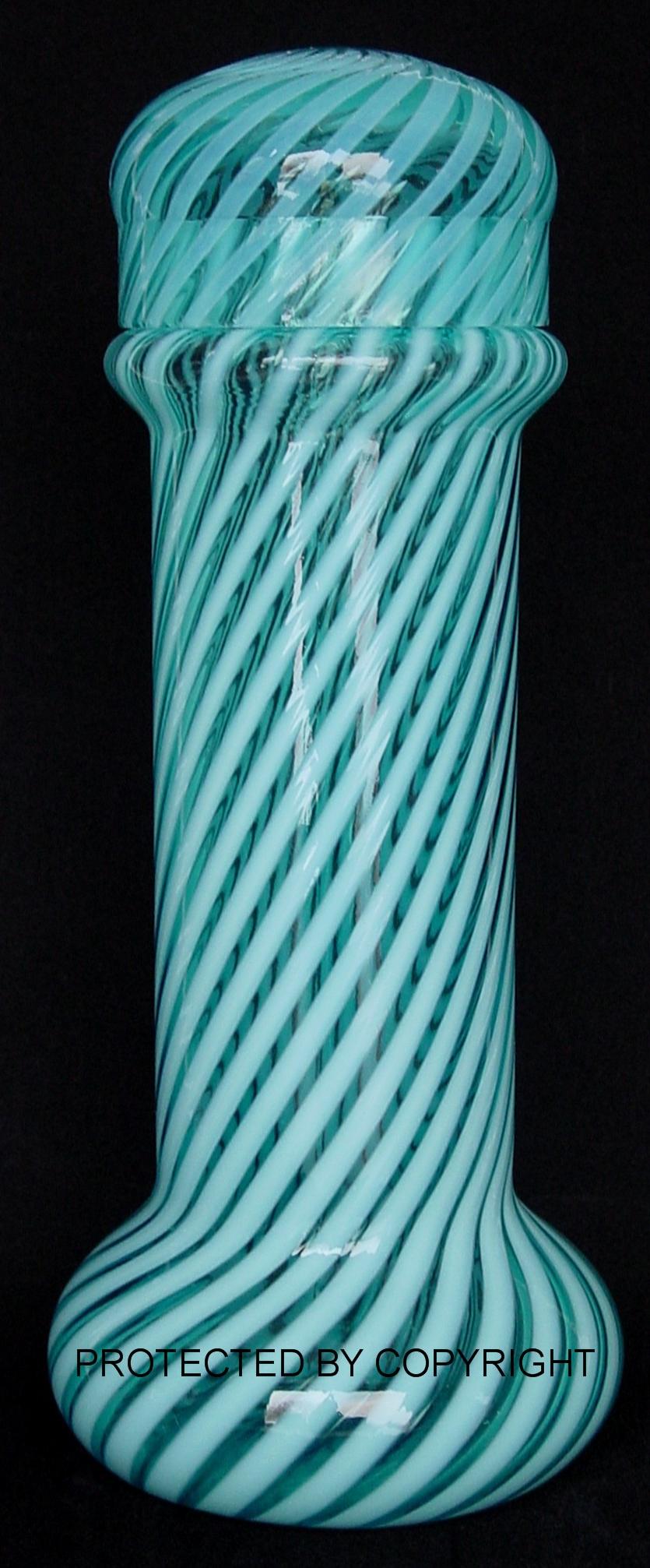 ........
........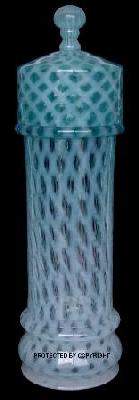 ........
........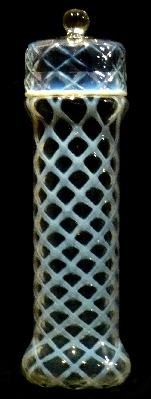
These Victorian era Straw Jars are the only complete jars (with covers) known to exist in
their respective colors. Photos are provided by a private collector and I am very excited to be able to show them.
The "Chrysanthemum Swirl Varient " jar on the left was made by Northwood. The "Swirl Opalescent" jar next
was made by the "West Virginia Glass Company". The "Bubble Lattice" jar next was made in England,
possibly in the Manchester area. The "Lattice Quilt" jar on the right is by the "H.C. Fox and Sons Flint Glass Works"
in Philadelphia, PA. Because these jars sat on marble counter tops in soda parlors, the covers were easily broken,
and today they are all but impossible to find. The jars by Northwood are the earliest known jars made in Opalescent
colors, circa: 1888, one year after Marvin Stone patented his invention for artificial paper straws in England.
Note:
Recently the collector has decided to share his collection and a new website has been created.
Here's the link
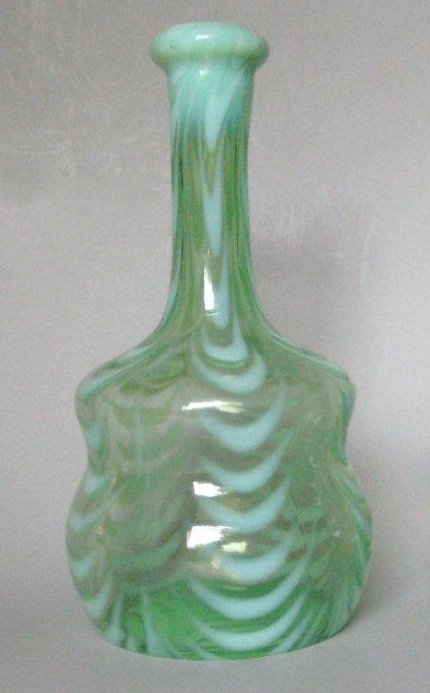 ........
........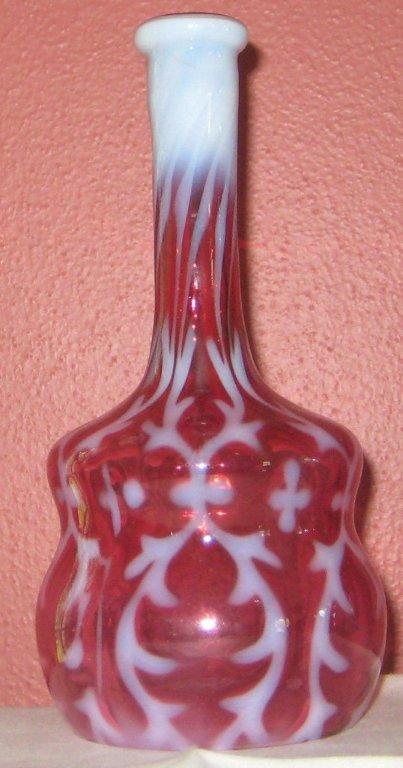 ........
........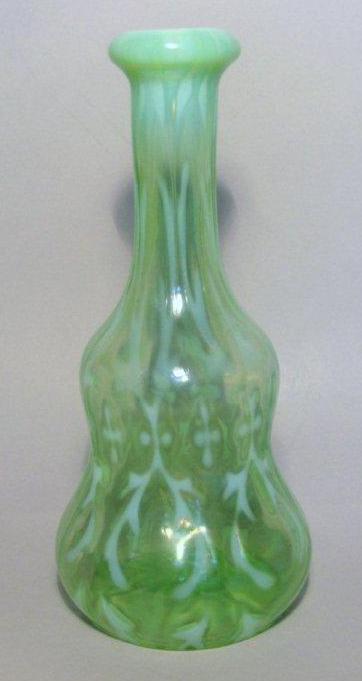
Here are several very rare Barber Bottles. The one on the
left is called Blown Drapery. This is the usual shape Blown
Drapery is found in and shown in Cranberry in another photo above.
In the middle is the same shape using Spanish Lace.
This version is extremely rare. Notice how much wider it is at the bottom
than the normal shape shown on the right. Photos are courtesy of collector Rick Graham.
Thanks for sharing. These are all Northwood bottles and are great to be able to show.
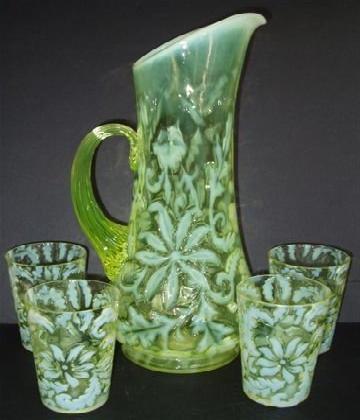
Until I was given this photo by a private collector, I would not have believed it. But photos don't lie.
The Poinsettia pattern by Northwood has never been known to be made in Vaseline Opalescent,
until know. Or is it possible that this set was made by Hobbs Brockunier? Notice the applied
reeded handle. Notice also, the Tankard mould shape is different from the Ring Neck mould used
by Northwood. Also the base diameter is much wider than the Ring Neck mould shape used by Northwood.
Consider also, that Hobbs made blown ware in Vaseline, and Poinsettia was originally a Hobbs pattern.
In any case, this is extremely rare and a joy to be able to show it. Enjoy!
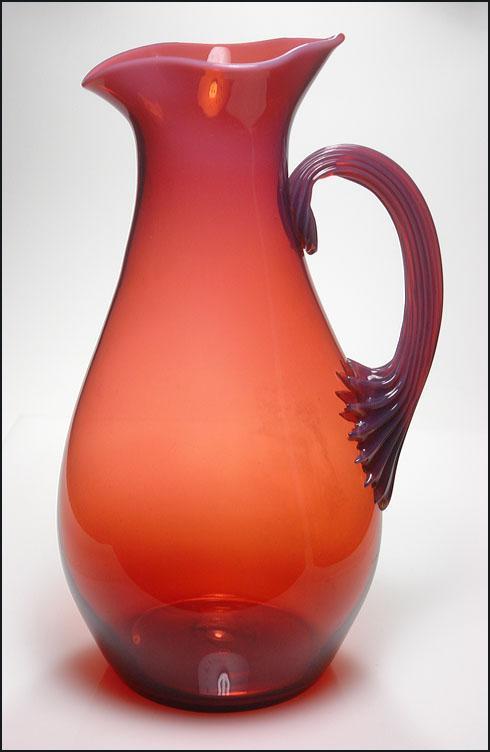
Here is one of the rarest colors you'll ever see in Opalescent Glass made in the 1800's.
This is true Red Opalescent. It's extremely Rare. This is a 13" tall Wine Jug.
It was made by the Reading Artistic Glass Works of Reading Pennsylvania.
This very short lived company was in business from 1884 - 1886. I've only seen one
other piece by this company in this color in 25 years. It's always a joy to behold.
If you have a piece of rare Opalescent Glass and you'd like to have it listed here, just
email me a photo.